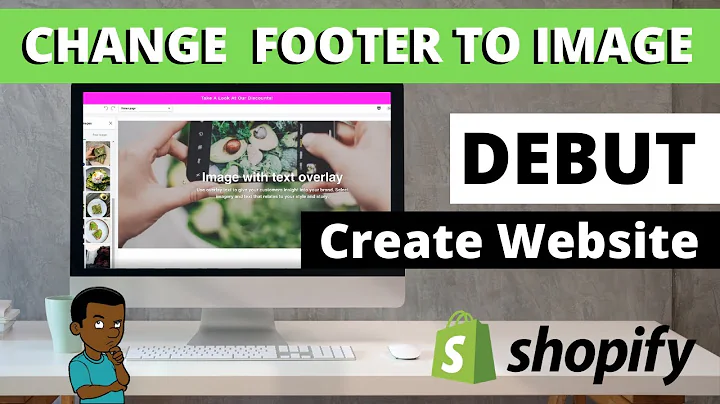Building and Deploying a Shopify App with Next.js
Table of Contents
- Introduction
- Setting Up the Repository
- Understanding the Folder Structure
- Working with Middleware
- Implementing Webhooks
- Using Prisma for Database Operations
- Building Proxy Routes
- Creating App Extensions
- Deploying the App
- Conclusion
Introduction
In this tutorial, we will learn how to create and deploy a new Shopify application using Next.js, Prisma ORM, and Shopify API version 7. We will cover the JavaScript version of the repository, with minimal differences in the TypeScript version. The tutorial will guide you through the entire process of setting up the repository, understanding the folder structure, working with middleware, implementing webhooks, using Prisma for database operations, building proxy routes, creating app extensions, and finally deploying the app.
Setting Up the Repository
Before we start, make sure you have cloned the repository and installed all the required packages using npm install. The repository contains everything needed to make your development process easier. The developer folder contains tools like the updating dashboard, while the components folder contains reusable components. The utils folder contains helpful utilities like middleware, providers, and encryption. The pages folder holds different pages and the API folder contains the server-side endpoints. The repository also includes examples, debug pages, and Prisma schema files.
Understanding the Folder Structure
The folder structure in the repository plays a crucial role in organizing the codebase. It is essential to familiarize yourself with the different folders and their purposes. The developer folder contains tools like the updating dashboard, which simplifies development tasks. The components folder contains reusable components like useFetch, which handles authorization headers for fetch requests. The providers folder contains average providers, although you may not require them often. The utils folder contains middleware, encryption, session handlers, and Prisma utilities. The pages folder contains the different pages of the app, including the underscore app, which wraps all components with necessary elements. The API folder contains the server-side endpoints, including GraphQL and REST proxies. The Prisma schema file manages the database operations, while the setup file ensures the proper setup of environment variables.
Working with Middleware
Middleware plays a crucial role in handling requests in the app. The repository provides a comprehensive middleware setup to enhance security and ensure proper request handling. The middleware folder contains middleware functions for request verification, HMAC validation, and content security policy. The verifyRequest middleware verifies every request, checks if a valid session exists, and authenticates the request. The verifyProxy middleware ensures secure authentication for app proxy routes. The verifyHmac middleware validates requests involving GDPR and sensitive data. It is essential to understand these middleware functions to ensure secure and properly authenticated requests.
Implementing Webhooks
Webhooks are essential for enabling real-time data syncing and event-based interactions between the app and Shopify. The API folder in the repository provides a webhook processing setup. The webhooks folder contains separate files for different webhook topics, allowing you to easily add new webhooks. The proxyRoutes folder handles requests related to app proxies and ensures proper authentication and delivery. The repository includes examples and explanations on how to set up and handle webhooks. Proper setup and handling of webhooks are crucial for the smooth functioning of the app and ensuring data sync.
Using Prisma for Database Operations
Prisma is an ORM (Object-Relational Mapping) tool that simplifies database operations. The schema.prisma file in the repository manages the database models and operations. You can define new tables and columns in the schema file and use the Prisma CLI to update the database. The repository provides examples on how to create new tables and perform CRUD operations using Prisma. Working with Prisma ensures seamless database operations and enhances the performance of your app.
Building Proxy Routes
Proxy routes allow for custom endpoints and enhanced functionality in your app. The repository provides examples and explanations on how to create and handle proxy routes. The setup file ensures the proper configuration of proxy routes. The proxyRoutes folder contains different proxies for specific routes. It is essential to understand how to configure and handle proxy routes to enable custom functionalities and integrations with external services.
Creating App Extensions
App extensions allow for additional functionalities and customizations within Shopify stores. The repository provides a comprehensive guide on how to create and deploy app extensions. The extensions folder contains separate files for different app extensions. You can create new extensions, define their functionalities, and deploy them using the Shopify CLI. Proper understanding and implementation of app extensions open up vast possibilities for customizing and enhancing Shopify stores.
Deploying the App
Finally, we will learn how to deploy the app to a production environment. The repository provides instructions on using Planet Scale to host the app and handle the database. You need to create a database on Planet Scale and update the environment variables in your deployment. The repository includes examples and explanations on how to update the environment variables, deploy the app, and ensure a seamless transition to the production environment. Proper deployment is essential to make the app accessible, scalable, and secure.
Conclusion
In this tutorial, we covered the entire process of creating and deploying a Shopify application using Next.js, Prisma ORM, and the Shopify API. We started by setting up the repository, understanding the folder structure, and configuring middleware. We then implemented webhooks, used Prisma for database operations, and built proxy routes. We also explored app extensions and learned how to deploy the app to a production environment. By following this tutorial, you will have a comprehensive understanding of building, deploying, and maintaining a Shopify app, allowing you to create powerful and customized solutions for Shopify stores.
Highlights
- Learn how to set up a Next.js Shopify app repository
- Understand the folder structure and purposes of different directories
- Implement middleware for enhanced security and request handling
- Set up and handle webhooks for real-time data syncing
- Utilize Prisma ORM for seamless database operations
- Build custom proxy routes for additional functionalities
- Create app extensions to customize Shopify stores
- Deploy the app to a production environment with Planet Scale hosting
FAQ
Q: What is the purpose of middleware in a Shopify app?
A: Middleware plays a crucial role in handling requests, verifying authenticity, and adding necessary headers. It enhances security and streamlines the request-handling process.
Q: Can I use Prisma with other databases besides PostgreSQL?
A: Yes, Prisma supports multiple databases, including MySQL. You can easily switch between databases by configuring the Prisma schema and environment variables.
Q: How do webhooks help in Shopify app development?
A: Webhooks enable real-time data syncing and event-based interactions between the app and Shopify. They allow your app to react to specific events happening in a Shopify store.
Q: Can I create custom endpoints in a Shopify app?
A: Yes, you can create custom endpoints using proxy routes. Proxy routes allow you to extend the functionality of your app and integrate it with external services.
Q: How do I deploy my Shopify app to a production environment?
A: To deploy your app, you need to set up a hosting provider like Planet Scale, configure environment variables, and ensure a smooth transition to the production environment.
Q: Can I customize the appearance and functionality of a Shopify store using app extensions?
A: Yes, app extensions allow you to add custom features and customize the user interface of a Shopify store. You can create extensions for specific purposes and enhance the overall store experience.


















